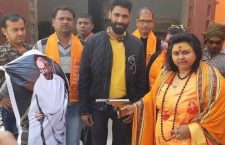Women in this Manikpur village say they have no other options.
In the village of Behla in Manikpur, Chitrakoot, there is no source of safe drinking water. So the women in the village walk nearly three kilometers–sometimes multiple times a day–through fields and forests, large swathes of it infamous bandit territory, to source water.
“When I make this trip, there is only one thing on my mind—that I hope and pray I don’t meet anyone along the way, that there is no problem on the way,” said Suman Devi, a Behla native. She described the route she and many other women frequent: “We come from the village, walking through the mustard fields. We are scared about someone ill-intentioned hiding in the tall growth.” She implied that the fear was of physical or sexual harassment when she added, matter-of-factly, “Of course, we are women.This is a primary fear.”
Chandravati Devi, another villager, echoed the same fears. “I feel scared making this trip alone,” she said, “I only hope everyday that there is no problem. I hope that nobody harasses me.” She has been making this trip for the last five or six years, despite the risks and her very palpable fear.
She isnot alone. “There are approximately 80 households in this village,” said Mukul, the husband of the village head Munni who wasn’t available for comment, “and yes, they all get their water from the well.” As for the water supply in the village? “The water that comes from the tap isn’t good, especially for drinking,” said Suman Devi, “If you fill a container with it, the water immediately turns red and looks like blood, an indication of the soil in Manikpur.” “If anyone drinks the water, they’ll get a fever and a cold,” said local Lakshmi Devi, “the impact is immediate.”
More than 16.3 crore people in India still don’t have access to clean water – it is the highest number in the world. Given that access to water is a necessity for all human life and a right protected by the Constitution, the National Rural Drinking Water Programme (NRDWP) was launched in April 2009 with the objective of providing safe and adequate water for drinking, cooking and other domestic needs to every rural person. By 2017, it was meant to provide access to safe drinking water to all rural habitations, government schools and anganwadis–and was assigned Rs. 89,956 crores in program funds. However, a Comptroller and Auditor General of India report said that the program had “failed”: despite spending 90% of the funds, 44% of rural habitations and 85% of government schools and anganwadi had access. At least 50% of all rural habitations were supposed to have access to safe water at 55 liters per capita per day by a piped water supply; only 18% actually did.
“We’ve demanded clean drinking water many times over,” said Karan, a Belha resident, “We’ve spoken to the village head, we’ve filled out an application.” Mukku, as the closest thing to administration willing to speak to our reporter, did not deny the existence of a problem, but did not seem particularly motivated to address it either: “We’ve made one effort which is to change the supply tap’s main pipeline, which is made out of plastic and put in ten years ago. It is possible that because it was only under the earth got cracked because of vehicular movement.” But in all of these years, the pipe in this village has not changed. Instead, trekking out to natural water bodies deep in the jungles has become the norm for these women.
And yet, official governmental data doesn’t reflect this failure. As recorded in a parliamentary response, 98.6% of all 2.6 lakh habitations in UP are fully covered, i.e. get more than 40 liters per capita per day of safe drinking water. Contamination is a non-issue too: of all 109 sources tested in Manikpur, none are contaminated above permissible limits. The Manikpur BDO refused to speak on camera but in person dismissed the complaint of the lack of safe drinking water as a frequent one despite the fact that there were many handpumps in the block. Even if that were the case, handpumps are hardly sources of safe drinking water–even though by Government guidelines they are, which could be one explanation for the bloated statistics– as they can be carriers of water-borne diseases.
According to the 2011 Census, nearly 56% of all rural households in UP didn’t have a source of drinking water within their household premises. The burden has always disproportionately fallen on women to find and transport water for themselves and their families.
And eight years later, at least for the women in Behla, who risk their safety everyday, this reality has not changed.
This Khabar Lahariya article first appeared on Firstpost

